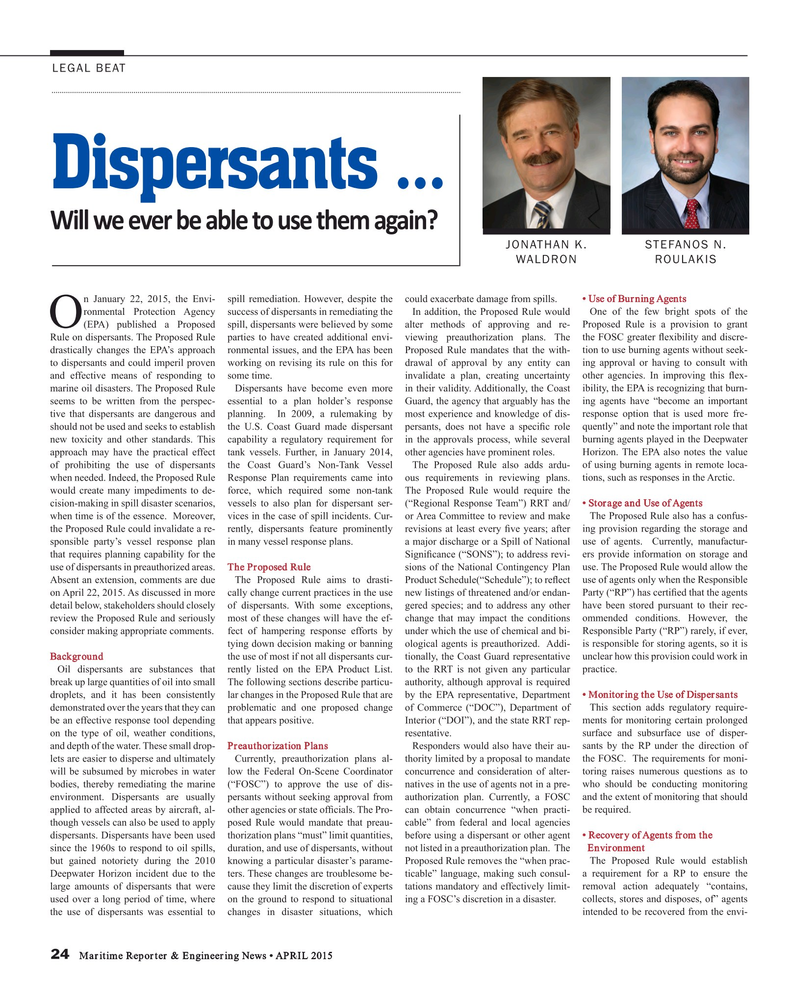
Page 24: of Maritime Reporter Magazine (April 2015)
Offshore Edition
Read this page in Pdf, Flash or Html5 edition of April 2015 Maritime Reporter Magazine
LEGAL BEAT
Dispersants ...
Will we ever be able to use them again?
JONATHAN K. STEFANOS N.
WALDRON ROULAKIS n January 22, 2015, the Envi- spill remediation. However, despite the could exacerbate damage from spills. • Use of Burning Agents ronmental Protection Agency success of dispersants in remediating the In addition, the Proposed Rule would One of the few bright spots of the
O(EPA) published a Proposed spill, dispersants were believed by some alter methods of approving and re- Proposed Rule is a provision to grant
Rule on dispersants. The Proposed Rule parties to have created additional envi- viewing preauthorization plans. The the FOSC greater ? exibility and discre- drastically changes the EPA’s approach ronmental issues, and the EPA has been Proposed Rule mandates that the with- tion to use burning agents without seek- to dispersants and could imperil proven working on revising its rule on this for drawal of approval by any entity can ing approval or having to consult with and effective means of responding to some time. invalidate a plan, creating uncertainty other agencies. In improving this ? ex- marine oil disasters. The Proposed Rule Dispersants have become even more in their validity. Additionally, the Coast ibility, the EPA is recognizing that burn- seems to be written from the perspec- essential to a plan holder’s response Guard, the agency that arguably has the ing agents have “become an important tive that dispersants are dangerous and planning. In 2009, a rulemaking by most experience and knowledge of dis- response option that is used more fre- should not be used and seeks to establish the U.S. Coast Guard made dispersant persants, does not have a speci? c role quently” and note the important role that new toxicity and other standards. This capability a regulatory requirement for in the approvals process, while several burning agents played in the Deepwater approach may have the practical effect tank vessels. Further, in January 2014, other agencies have prominent roles. Horizon. The EPA also notes the value of prohibiting the use of dispersants the Coast Guard’s Non-Tank Vessel The Proposed Rule also adds ardu- of using burning agents in remote loca- when needed. Indeed, the Proposed Rule Response Plan requirements came into ous requirements in reviewing plans. tions, such as responses in the Arctic.
would create many impediments to de- force, which required some non-tank The Proposed Rule would require the cision-making in spill disaster scenarios, vessels to also plan for dispersant ser- (“Regional Response Team”) RRT and/ • Storage and Use of Agents when time is of the essence. Moreover, vices in the case of spill incidents. Cur- or Area Committee to review and make The Proposed Rule also has a confus- the Proposed Rule could invalidate a re- rently, dispersants feature prominently revisions at least every ? ve years; after ing provision regarding the storage and sponsible party’s vessel response plan in many vessel response plans. a major discharge or a Spill of National use of agents. Currently, manufactur- that requires planning capability for the Signi? cance (“SONS”); to address revi- ers provide information on storage and use of dispersants in preauthorized areas. The Proposed Rule sions of the National Contingency Plan use. The Proposed Rule would allow the
Absent an extension, comments are due The Proposed Rule aims to drasti- Product Schedule(“Schedule”); to re? ect use of agents only when the Responsible on April 22, 2015. As discussed in more cally change current practices in the use new listings of threatened and/or endan- Party (“RP”) has certi? ed that the agents detail below, stakeholders should closely of dispersants. With some exceptions, gered species; and to address any other have been stored pursuant to their rec- review the Proposed Rule and seriously most of these changes will have the ef- change that may impact the conditions ommended conditions. However, the consider making appropriate comments. fect of hampering response efforts by under which the use of chemical and bi- Responsible Party (“RP”) rarely, if ever, tying down decision making or banning ological agents is preauthorized. Addi- is responsible for storing agents, so it is
Background the use of most if not all dispersants cur- tionally, the Coast Guard representative unclear how this provision could work in
Oil dispersants are substances that rently listed on the EPA Product List. to the RRT is not given any particular practice.
break up large quantities of oil into small The following sections describe particu- authority, although approval is required droplets, and it has been consistently lar changes in the Proposed Rule that are by the EPA representative, Department • Monitoring the Use of Dispersants demonstrated over the years that they can problematic and one proposed change of Commerce (“DOC”), Department of This section adds regulatory require- be an effective response tool depending that appears positive. Interior (“DOI”), and the state RRT rep- ments for monitoring certain prolonged on the type of oil, weather conditions, resentative. surface and subsurface use of disper- and depth of the water. These small drop- Preauthorization Plans Responders would also have their au- sants by the RP under the direction of lets are easier to disperse and ultimately Currently, preauthorization plans al- thority limited by a proposal to mandate the FOSC. The requirements for moni- will be subsumed by microbes in water low the Federal On-Scene Coordinator concurrence and consideration of alter- toring raises numerous questions as to bodies, thereby remediating the marine (“FOSC”) to approve the use of dis- natives in the use of agents not in a pre- who should be conducting monitoring environment. Dispersants are usually persants without seeking approval from authorization plan. Currently, a FOSC and the extent of monitoring that should applied to affected areas by aircraft, al- other agencies or state of? cials. The Pro- can obtain concurrence “when practi- be required.
though vessels can also be used to apply posed Rule would mandate that preau- cable” from federal and local agencies dispersants. Dispersants have been used thorization plans “must” limit quantities, before using a dispersant or other agent • Recovery of Agents from the since the 1960s to respond to oil spills, duration, and use of dispersants, without not listed in a preauthorization plan. The Environment but gained notoriety during the 2010 knowing a particular disaster’s parame- Proposed Rule removes the “when prac- The Proposed Rule would establish
Deepwater Horizon incident due to the ters. These changes are troublesome be- ticable” language, making such consul- a requirement for a RP to ensure the large amounts of dispersants that were cause they limit the discretion of experts tations mandatory and effectively limit- removal action adequately “contains, used over a long period of time, where on the ground to respond to situational ing a FOSC’s discretion in a disaster. collects, stores and disposes, of” agents the use of dispersants was essential to changes in disaster situations, which intended to be recovered from the envi- 24 Maritime Reporter & Engineering News • APRIL 2015
MR #4 (18-25).indd 24 MR #4 (18-25).indd 24 3/31/2015 11:02:49 AM3/31/2015 11:02:49 AM

 23
23

 25
25
